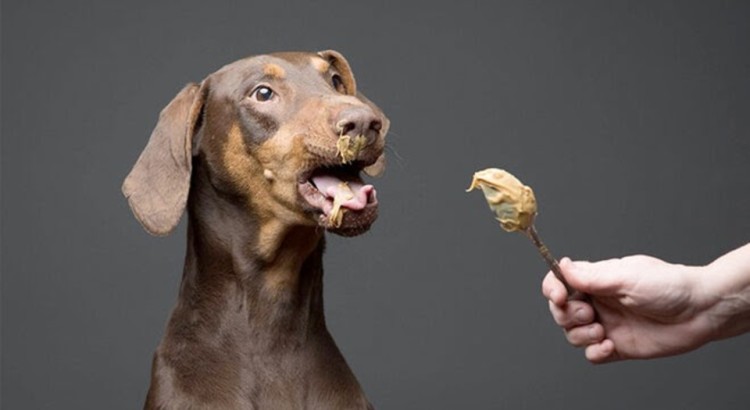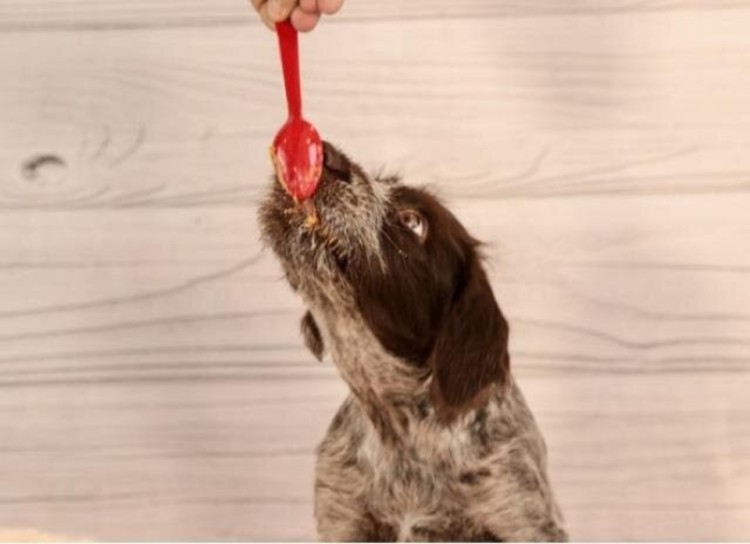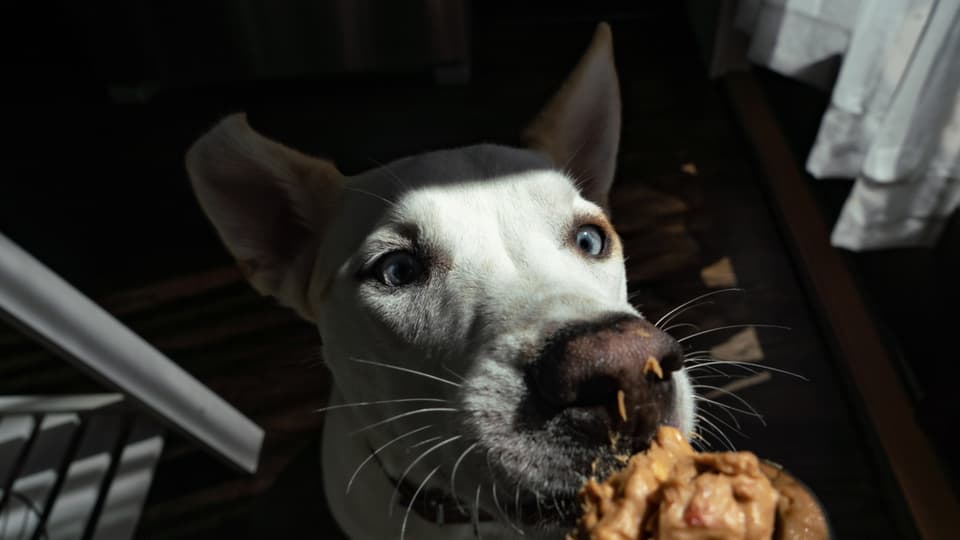There's no doubt that pups love peanut butter, but is it actually good for them? Even though peanut butter is an ingredient in many commercial dog treats, the answer might surprise you.
While there are many peanut butter brands that are harmless to your canine companion, certain types contain ingredients that can be harmful to dogs. So, before you let your pooch indulge in peanut butter, there are a few facts you need to know.
Pro tip: Has your pooch managed to empty a peanut butter jar when you weren’t watching? Vet bills can be expensive but having a dog insurance policy will cover the impacts of your pet ingesting potentially toxic ingredients and give you some peace of mind.
 Image source: Pin Paws
Image source: Pin Paws
Is Peanut Butter Good for Dogs?
Peanut butter is packed with protein, natural fats, vitamins E, B, and niacin. However, large amounts can result in obesity, as well as other health issues like pancreatitis.
The amount of peanut butter will depend on the individual dog, as well as the brand of peanut butter (be sure to check the caloric count on the label). In general, larger dogs should get one tablespoon, whereas smaller ones should get no more than half a tablespoon a day.
Call your vet to discuss whether peanut butter is safe for your pet and how much you should give. This is especially important for pups that have underlying medical conditions like diabetes,food sensitivities, or chronic pancreatitis.
Another thing to take into consideration is the amount of peanut butter you’re serving. Remember the 90/10 rule: 10% of your pup’s diet should consist of treats and the rest 90% should be their regular dog food. Also, it might be a good idea to alternate between peanut butter and healthier treats, like dog-safe fruits and veggies.
Which Dogs Should Stay Away from Peanut Butter?
-
For pups with chronic pancreatitis or those at risk for developing pancreatitis such as Yorkshire Terriers and Miniature Schnauzers - even a small amount of high-fat treat like peanut butter can be enough to cause or worsen their condition, so it should be avoided altogether.
-
If your furry pal is sensitive or allergic to some foods or has been prescribed a special diet, it’s best to stay safe by feeding them what they usually eat.
-
Pups with kidney problems should not eat peanut butter as it can contain high salt levels which may make their condition worse
-
Peanut butter contains about 180-200 calories per two tablespoons—most of which comes from fat. This makes it less than ideal for overweight pets. If you’re looking for training treats, opt for leaner alternatives like tuna, chicken, and ham.
What Type of Peanut Butter is Best for Your Pup?
If you’re looking to choose the best peanut butter option, you should check the label for preservatives and extra sugar. Some brands also contain added salt which makes them high in sodium, as well as certain fats like palm oil. Your best bet is to find a peanut butter brand that’s free of additives or prepare your own, homemade version with only one ingredient - peanuts.
When reading the label, be careful with terms like "100% natural" or "no artificial sweeteners". Xylitol is technically an "all-natural" sweetener but can be extremely toxic to your furry companion!
The Dangers of Xylitol
Xylitol is a sugar substitute found in sugar-free products such as toothpaste, baked goods, supplements, ice creams, and chewing gums. This artificial sweetener is perfectly safe for humans but can be very toxic to dogs.
Even an extremely small amount can cause a rapid release of insulin which, in turn, results in a rapid decrease in blood sugar levels. This condition (hypoglycemia) can occur as quickly as an hour after consuming xylitol and, if left untreated, it can be fatal.
If your furry pal eats a product containing xylitol, they might exhibit the following symptoms:
- Rapid breathing
- Pale gums
- Diarrhea
- Change in body temperature
- Rapid or weak pulse
- Trouble standing
- Staggered walking
- Liver failure
- Unconsciousness
- Seizures
If you notice any of these symptoms, make sure to seek medical treatment right away. On your way to the vet, you can try to raise their blood sugar by rubbing maple or corn syrup on their gums, but this is only a temporary solution.
 Image source: Dogster
Image source: Dogster
What Else to Watch out For
Besides xylitol, peanut butter can contain other ingredients that can pose a threat to your dog’s health.
Aflatoxins
Most peanut butter contains aflatoxins, one of the most carcinogenic substances on the planet. Research has shown that aflatoxin can cause liver cancer in laboratory animals and is a risk for your pet as well. What’s worse, this toxic ingredient is even more common in the organic alternatives, as they’re not sprayed with glyphosate or other chemicals that kill it.
On the other hand, glyphosate, which is a common herbicide used by many major brands, can also cause health issues in dogs. According to NPIC, glyphosate symptoms in dogs include vomiting, diarrhea, lethargy, weight loss, and excessive drooling. Tests have also shown that 15% of dogs who eat grass treated with glyphosate herbicides develop serious symptoms of toxic reaction.
Lectins
Lectins are proteins that can cause gut inflammation, irritating the cells lining the digestive tract and causing them to open up. This condition is called a leaky gut. When leaky gut is present, lectins escape into the bloodstream, where they trigger an inflammatory response. If inflammation persists, it might lead to chronic organ disease like arthritis, heart disease, kidney disease, allergies, and cancer.
Lectins also bind to sugars and carbohydrates in the body and interrupt messaging between inflammatory reactions and cells. In addition, they are anti-nutrients, i.e. they interfere with the proper absorption of important proteins, vitamins, and minerals.
Unbalanced fats
You’ve probably heard that peanuts are rich in good omega-3 and omega-6 fats. The problem is, the ratio of these fats in peanut butter is highly unbalanced: a cup of peanuts contains 35.578 mg of omega-6 and only about 195 mg of omega-3s. That’s about 5000 times more omega-6 than omega-3!
When it comes to good fats, they’re only good if consumed in the correct ratio. Too much omega-6 can raise blood pressure, lead to blood clots, and cause the body to retain water. Omega-6 fatty acids are already represented in most of the foods your furry pal is exposed to, so feeding them peanut butter can only make things worse.
Harmful fats
Trans-fatty acids are the result of hydrogenation, a process that makes foods more stable and more durable. They have been linked to chronic inflammation that can cause a number of diseases like heart disease and diabetes.
That’s why you need to check the label before buying peanut butter for your pooch. If you spot the words ‘hydrogenated’ or ‘partially hydrogenated oils’ in the ingredient list, stay away from it.
Sugar
White sugar is responsible for feeding nasty things like bacteria, yeast, parasites, and even cancer cells. This means that the more sugar we (and our furry friends) consume, the more these grow and spread. Sugar can also lead to diabetes, premature aging, low-level inflammation, and food allergies.
Can Dogs Be Allergic to Peanuts?
While sudden, severe allergic reactions typical in people suffering from nut allergies are rare in dogs, other allergic symptoms might occur. To stay on the safe side, if you are feeding peanut butter for the first time, start with a very small amount and monitor your pet.
Signs of a chronic food allergy in dogs include:
- Thin fur coat
- Recurrent ear infections
- Recurrent problems with anal glands
- Chronic itchiness
Signs of an acute allergic reaction in dogs include:
- Vomiting
- Diarrhea
- Difficulty breathing or rapid breathing
- Severe itchiness
- Hives
- Swelling around their muzzle and/or eyes
- Collapse
If you notice these symptoms after feeding peanut butter to your four-legged friend, stop immediately and get in touch with your veterinarian, who will be able to help figure out whether your pet is allergic to peanuts or something else. Also, make sure to speak to your vet before introducing any new foods to your dog’s diet.
Compare pet insurance policies to help you manage vet bills that might occur from treating an allergic reaction in your canine companion.
Is PB&J Safe for Dogs?
Enjoying your PB&J sandwich and wondering whether you should share it with your pooch?
While peanut butter can be safe for your four-legged friend if given in moderate amounts, jelly is an absolute no-no. This is because jelly, jam, and preserves contain lots of sugar. So, if you are already treating your dog with peanut butter, adding more sugar will increase the risk of diabetes and obesity even more.
Some jelly brands also contain xylitol and some types are made from fruits that aren’t dog-safe, like grapes. Grapes (as well as currants and raisins) can be toxic to dogs and cause acute kidney failure.
 Image source: PetMD
Image source: PetMD
Ways to Treat Your Doggy With Peanut Butter
Here are a few fun ways to feed peanut butter to your four-legged pal:
Use it to give medication. Giving medication is often stressful as most pups won’t eat it plain. Use peanut butter’s deliciousness to conceal the flavor and texture of pills.
Make bathtime less stressful. Smear some peanut butter on the wall of your shower or tub to distract your pup during bath time (or while clipping their nails). They’ll be busy licking it and less focused on being shampooed, making the whole experience a lot easier for both of you.
Sweeten the entertainment. Fill a treat toy with some peanut butter and let your high-energy furry companion lick during chill out time.
Use it for training. Give some peanut butter to your pooch after they have shown good behavior or done what they were asked to do. This will make them more likely to do good again next time as they’ll remember getting an extra tasty treat.
Final Thoughts
The bottom line is, your canine companion can eat peanut butter as long as it’s fed in moderation and doesn’t contain xylitol. Don’t forget to alternate peanut butter with other healthy treats and you’ll make sure that your pup is satisfied.
If you have any questions or concerns about your pet’s diet, get in touch with your vet for recommendations and advice.
